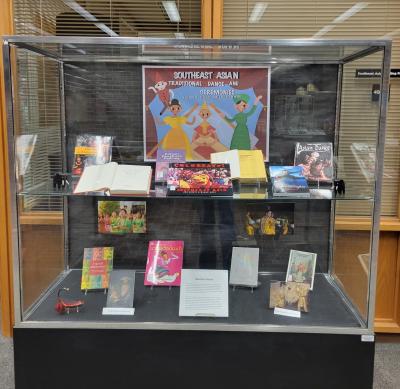Northern Illinois University Libraries are home to a vital, growing Southeast Asia (SEA) Collection, probably the largest in Illinois. The university is home to a Center for Southeast Asian Studies (https://www.niu.edu/clas/cseas/index.shtml) and several Southeast Asian languages are taught on campus, including Thai, Burmese, and Indonesian. The library is a vital part of Southeast Asian studies on campus, with a collection of hundreds of thousands of items. Some of these fascinating items are displayed in periodic exhibits in the collection area. The current exhibition in the Southeast Asia collection features an overview of traditional dances from several Southeast Asian countries.
This exhibit was developed in conjunction with International Education Week. Every year the SEA Collection partners with the NIU Division of International Affairs to create an exhibit highlighting an aspect of Southeast Asian life and culture. Traditional dance is an expression of cultural identity for the people of Southeast Asia. The dances are used to tell stories and perform the rituals of different groups of Southeast Asian people. Burmese dance can be distinguished by angular, fast-paced, and energetic movements and emphasis on pose, not movement. It is divided into three categories: dramatic, folk and village, and nat dance (spiritual dance). Cambodian dance consists of three main categories: classical dance of the royal court, folk dance that portrays cultural traditions, and social dances performed in social gatherings. Indonesian dance reflects the country's diversity of ethnicities and cultures. There are more than 1,300 ethnic groups in Indonesia. Each ethnic group has its own dances: there are more than 3,000 original dance forms. Philippine dance has played a tremendous role in Filipino culture. From one of the oldest dated dances called the Tinikling to other folkloric dances such as the Pandanggo, Cariñosa, and Subli, and even to more modern-day dances like the ballet, dance in the Philippine setting has integrated itself into society over the course of many years. Dance in Thailand is the main dramatic art form. There are two types: high art (classical dance) and low art (folk dance). The exhibit features books, photos, and posters of the various aspects of dance in these countries and will be up through the end of January 2023. We create several different exhibits each year.
Faculty members, students, and the public are welcome to visit the exhibit when the library is open. We tell faculty about the exhibits so that they can encourage students to visit. Due to the pandemic, we have not had many events in the library recently. Still, in the future, it would be great to have events in conjunction with exhibits, such as a demonstration of traditional dance.
Today's guest blog post is by Joanna Kulma, Library Specialist in the Southeast Asia Collection, at Northern Illinois University Library


